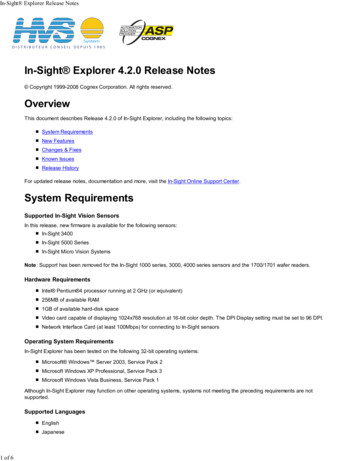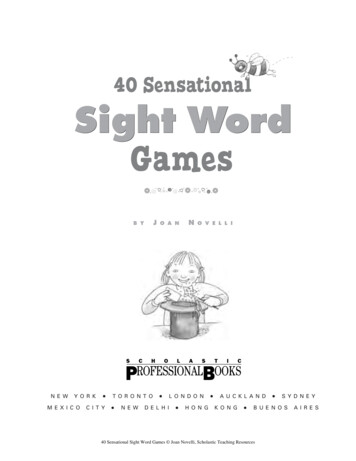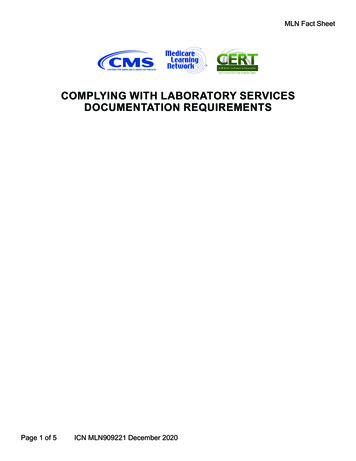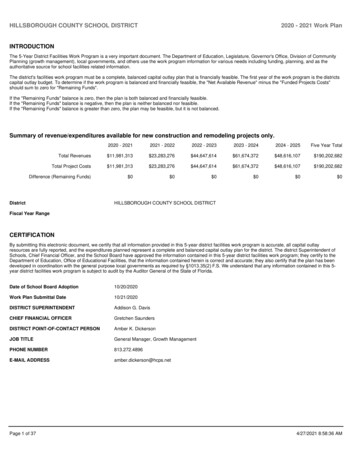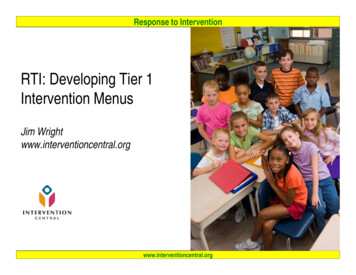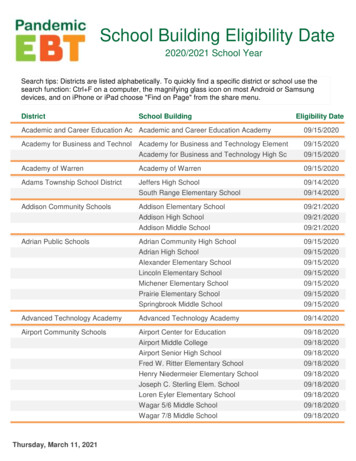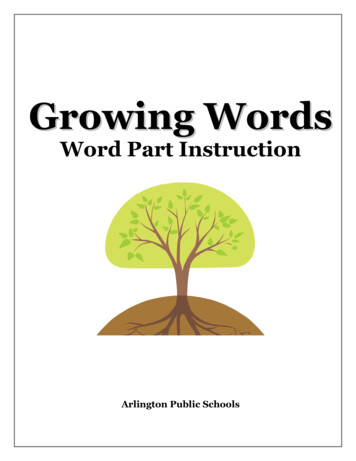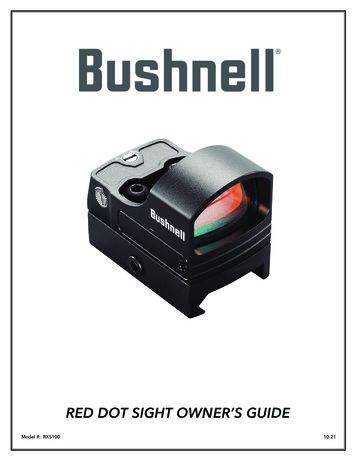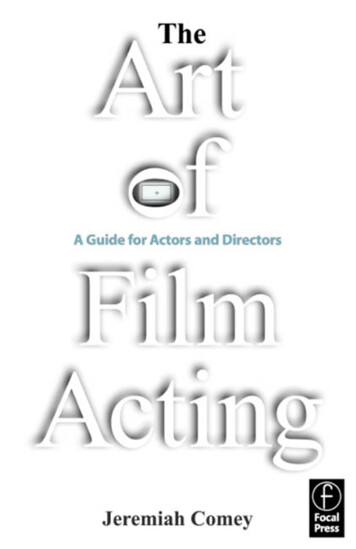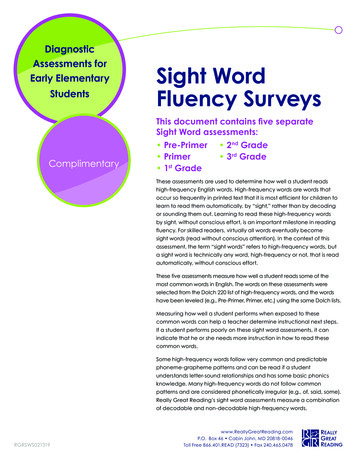
Transcription
DiagnosticAssessments forEarly ElementaryStudentsComplimentarySight WordFluency SurveysThis document contains five separateSight Word assessments: Pre-Primer 2nd Grade Primer 3rd Grade 1st GradeThese assessments are used to determine how well a student readshigh-frequency English words. High-frequency words are words thatoccur so frequently in printed text that it is most efficient for children tolearn to read them automatically, by “sight,” rather than by decodingor sounding them out. Learning to read these high-frequency wordsby sight, without conscious effort, is an important milestone in readingfluency. For skilled readers, virtually all words eventually becomesight words (read without conscious attention). In the context of thisassessment, the term “sight words” refers to high-frequency words, buta sight word is technically any word, high-frequency or not, that is readautomatically, without conscious effort.These five assessments measure how well a student reads some of themost common words in English. The words on these assessments wereselected from the Dolch 220 list of high-frequency words, and the wordshave been leveled (e.g., Pre-Primer, Primer, etc.) using the same Dolch lists.Measuring how well a student performs when exposed to thesecommon words can help a teacher determine instructional next steps.If a student performs poorly on these sight word assessments, it canindicate that he or she needs more instruction in how to read thesecommon words.Some high-frequency words follow very common and predictablephoneme-grapheme patterns and can be read if a studentunderstands letter-sound relationships and has some basic phonicsknowledge. Many high-frequency words do not follow commonpatterns and are considered phonetically irregular (e.g., of, said, some).Really Great Reading’s sight word assessments measure a combinationof decodable and non-decodable high-frequency words.RGRSWS021319www.ReallyGreatReading.comP.O. Box 46 Cabin John, MD 20818-0046Toll Free 866.401.READ (7323) Fax 240.465.0478
Really Great Reading Sight Word Fluency SurveysContentsSight Word Fluency Survey.3Summary Directions.3Administration Script for Sight Word Fluency Survey.4Scoring Guidelines.5Scoring Words in Sentences (Set 1).5Scoring Words in Isolation (Set 2).6Sight Word Skill Levels.7Utilizing the Results to Drive Instruction.7Sight Word Survey—Pre-Primer. 8-9Words and Sentences to Read.8Teacher Recording Form.9Sight Word Survey—Primer. 10-11Words and Sentences to Read.10Teacher Recording Form.11Sight Word Survey—1st Grade. 12-13Words and Sentences to Read.12Teacher Recording Form.13Sight Word Survey—2nd Grade. 14-15Words and Sentences to Read.14Teacher Recording Form.15Sight Word Survey—3rd Grade. 16-17Words and Sentences to Read.16Teacher Recording Form.172 2017 Really Great Reading COMPLIMENTARY VERSION – Sight Word Surveys January 2017
Really Great Reading Sight Word Fluency SurveysSight Word Fluency SurveysSummary DirectionsTARGET AUDIENCE & PURPOSE Give to all emerging readers (kindergarten and 1st grade) or older students (Grades 2-12) whom you suspect arenot mastering sight words at an appropriate pace. Allows for quick identification of a student’s mastery of and automaticity with sight word identification.WHAT IS ASSESSEDThis survey assesses sight word recognition and accuracy. The term “sight word” can refer to a high-frequency word, orto any word (high-frequency or not) that is read automatically, without conscious effort. In the context of this assessment,the term “sight word” refers to the high-frequency words from the Dolch 220 list. A variety of Dolch 220 high-frequencywords are presented in context (in simple, short sentences) and in isolation.MATERIALS Sight Word Fluency Survey – Student Page Sight Word Fluency Survey – Recording & Scoring Form Pen or pencilADMINISTRATION Give student a copy of the Student Page. See page 4 for suggested administration script.RECORDINGUse the Recording & Scoring Form: Place checkmark (P) next to correct responses:o Set 1: Place checkmark (P) in the appropriate box (A Words Read Automatically or E Words Read withEffort). Words Read Automatically are words the student correctly reads quickly, without hesitation. Words Readwith Effort are words the student correctly reads after some hesitation or apparent effort.o Set 2: Place checkmark (P) in the appropriate column (Words Read Automatically or Words Read with Effort). For errors, record the student’s incorrect response in the space provided.o When the student misreads the same word multiple times, record all incorrect responses. Self-Corrections are words that the student reads incorrectly the first time, but then goes back and correctly readsindependently with no prompting. If the student self-corrects, write the incorrect response on the line providedafter the target word, circle the target word, and write the letters SC next to the incorrect response. If the student makes no attempt to read a word or says “I don’t know,” check NT for No Try (Set 1), or write NT next tothe target word (Set 2). Record additional comments and observations in the spaces provided.SCORINGAfter administration: Tally correct responses for each part (Sets 1 and 2). Self-corrections DO count as errors. Total all correct responses (Words Read Automatically and Words Read with Effort). See pages 3-4 for several scoring examples. 2017 Really Great Reading COMPLIMENTARY VERSION – Sight Word Surveys January 20173
Really Great Reading Sight Word Fluency SurveysAdministration Script forSight Word Fluency SurveysStep 1 Give student the page titled “Words and Sentences to Read.”Step 2 Introduce survey to student. Say:oI am going to ask you to read these sentences and words.oI won’t time you.oDo your very best reading. It is more important to read accurately than fast.oPlease read slowly enough so I can take notes.Step 3 Guide student to read the page.oSet 1—Point and say: oPlease read these sentences, one at a time.Set 2—Point and say: Please read these words. Start here (point to the first word) and read across the page (point to the last word in the first row).Step 4 Optional—Tell the student how many words he or she read correctly.o Count the number of checkmarks for words read correctly in each set: Automatically (A) or With Effort (E).oSay, “You read words correctly!” Dismiss the student or continue with other scheduled assessments.Step 5 For each set, total the number of words in each column, and record the total in the appropriate boxes forSet 1 and Set 2:o Read Automatically (A)o Read with Effort (E)o Misread, then Self-Corrected (target word circled and marked with SC)Step 6 Total the words read correctly on the recording form (Sets 1 and 2):o Add together the total number of words read correctly in Sets 1 and 2 (Words Read Automatically and WordsRead with Effort). Record this number at the bottom of the Recording Form in the Total Words Read Correctly(Set 1 Set 2) box. Remember, self-corrections DO count as errors, so those should not be counted in the Total Words ReadCorrectly box.4 2017 Really Great Reading COMPLIMENTARY VERSION – Sight Word Surveys January 2017
Really Great Reading Sight Word Fluency SurveysScoring GuidelinesSight Word Surveys can now be entered into the Grouping Matrix. If your school has an account, simply scroll down onthe Student Record page. Results can be entered through Live Assess or Enter New Score. If you utilize Live Assess, it willscore and enter the results into the Student Record for you. The Student Record will also tell you where the student is atmastering sight words according to the sight word levels.If you need access to the Grouping Matrix please email us at groupingmatrix@reallygreatreading.com with your State,District and School names. Follow the guidelines and examples below for scoring the students’ responses to the sightwords on the survey by hand.Scoring Words in Sentences (Set 1)Score the words read correctly in sentences (Set 1) by placing a checkmark (P) next to the word in the appropriate box.The boxes are labeled A for Read Automatically and E for Read with Effort. See example 1 below.If a student misreads a word in one of the sentences, write his incorrect response(s) on the line(s) provided to the right ofthe target word. See example 2 below.If a student misreads a word in one of the sentences and then self-corrects without prompting, write his incorrectresponse on the line provided, and mark it with an SC. See example 3 below.If a student skips over a word, check the box labeled NT for No Try. You may also wish to circle any words the studentmisreads in the grade level boxes to the right of the sentences on the recording form. This will help you easily identifyany particular grade levels (Pre-Primer through 3 rd Grade) of sight words with which the student struggled.EXAMPLE 1The student read the sentence “They walk.” accurately. The word “they” was read automatically (A), and the word“walk” was read with effort (E). Place a checkmark (P) next to each word in the appropriate box.EXAMPLE 2The student misread the word “funny” as “fun” and did not self-correct. Write “fun” on the line provided to the right ofthe target word.EXAMPLE 3The student misread the word “so” as “such” and then self-corrected. Write “such” on the line provided to the right ofthe target word “so,” and then circle the target word and write SC to the right of the word to indicate a self-correction.Sight Word Fluency Survey Recording FormPPP1sttheywalkCheck appropriate box below. Circle target word for self-corrections (SC).1231-2A EThey p3-6IA E NTso7-10NTsuchWetoSCA E NTA E NTA E NTpwalkA E NTamA E NTfunnyfunA E NT.I, funnyam, sowe, to,playlike.likeA E NTplayA E NT. 2017 Really Great Reading COMPLIMENTARY VERSION – Sight Word Surveys January 20175
Really Great Reading Sight Word Fluency SurveysScoring Words in Isolation (Set 2)Score the words read correctly in isolation (Set 2) by placing a checkmark (P) next to the word in the appropriatecolumn: Read Automatically or Read with Effort. Remember that self-corrections (indicated by marking with SC) DOcount as errors. See examples 4 and 5 below.If a student skips over a word, write NT, for No Try, next to the target word.If a student misreads a word in isolation, write the incorrect response(s) in the Words Read Incorrectly column.See example 6 below.EXAMPLE 4The student read the words “look,” “down,” and “see” accurately. The word “look” was read with effort, the word“down” was read automatically, and the word “see” was read with effort. Place a checkmark (P) in the appropriatecolumn for each word.EXAMPLE 5The student misread the word “there” as “they” and then self-corrected. Write the word “they” in the Read Incorrectly(I) column, and mark with an SC to indicate a self-correction.EXAMPLE 6The student misread the word “now” as “no” and did not self-correct. Write the incorrect response in the ReadIncorrectly (I) column.4PrePrimerReadIncorrectly ll43outReadAutomatically (A)pReadwith Effort (E)NotespptheynoSC 2017 Really Great Reading COMPLIMENTARY VERSION – Sight Word Surveys January 2017
Really Great Reading Sight Word Fluency SurveysSight Word Skill Levels The following guidelines can be used to determine a student’s level of proficiency with the sight words on the Sight WordFluency Survey. These are basic guidelines based upon the number of words at each grade level on the survey. Notethat the survey only assesses students’ proficiency with the specific words that have been included in the sentencesand in isolation. There may be many sight words not included on the survey that a student has already mastered. Thesurvey is simply meant to paint a broad and general picture of a student’s proficiency with sight words at various gradelevels. Below is a breakdown of the number of words from each level on the surveys.Pre-Primer:25 wordsPre-Primer – 25Primer:25 wordsPre-Primer – 8Primer – 171st Grade:50 WordsPre-Primer – 12Primer – 131st Grade – 25Beginning of YearAssessmentName2nd Grade:50 WordsPre-Primer – 7Primer – 91st Grade – 92nd Grade –25Middle of Year3rd Grade:50 WordsPre-Primer – 7Primer – 51st Grade – 62nd Grade – 73rd Grade –25End of YearLowEmergingOn TrackLowEmergingOn TrackLowEmergingOn TrackKinderPre-Primer0-25%25%-60% 60%0-45%45%-75% 75%0-75%75%-90% 90%KinderPrimer0-25%25%-60% 60%0-45%45%-75% 75%0-75%75%-90% 90%1st Grade0-50%50%-75% 75%0-60%61%-80% 80%0-75%75%-90% 90%2nd Grade0-50%50%-75% 75%0-60%61%-80% 80%0-75%75%-90% 90%3rd Grade0-50%50%-75% 75%0-60%61%-80% 80%0-75%75%-90% 90%Utilizing the Results to Drive InstructionInstructional Recommendations: You may wish to provide explicit instruction in reading with automaticity the specific words on the survey that astudent has not mastered. You may wish to create flash cards with the words that students read incorrectly on the survey to provide studentswith additional practice. You may wish to ask students to read additional words from the Dolch 220 list to determine if they have masteredsight words other than those on this survey. You can also use the survey results as a guide for identifying the grade levels of the Dolch 220 sight word list withwhich a student needs more practice.If you observe students reading the words on this survey accurately but slowly, this is an indication that students shouldwork on the speed with which they can recognize sight words. You can do this by utilizing flash cards and speed drills orthrough the Heart Word activities on Countdown Online, Blast Online, and HD Word Online.You should take note of students who consistently read sight words incorrectly and then self-correct. These students mayneed additional practice with slowing down and paying attention to every word, including sight words, while readingconnected text. 2017 Really Great Reading COMPLIMENTARY VERSION – Sight Word Surveys January 20177
Pre-PrimerSight Word SurveyWords and Sentences to ReadSet 11.2.3.?4.?5.6.Set 28saidforgothewelittleherenot 2017 Really Great Reading COMPLIMENTARY VERSION – Sight Word Fluency Surveys January 2017
StudentGradeExaminerDateFOUNDATIONALSKILLS ASSESSMENTSIGHT WORD SURVEYPRE-PRIMERSight Word Fluency Survey Recording FormSet 1Check appropriate box below. Circle target word for self-corrections (SC).1-2I3-4Look5-7RunA E NTme8-1011-13A E NT .downA E NTtoA E NThelpA E NTWhereA E NTyouA E NTisComeA E NTA E NTA E NT?A E NTA E NTandA E NT .A E NT .Canit14-17A E NTsee?jumpA E NTplayA E NT .Total Set 1 Words ReadCorrectly (A E)Observations:Total ATotal ETotal SC(Self-correction)PrimerSet 2PrePrimerReadIncorrectly l Set 2 Words ReadCorrectly (A E)Total SCReadAutomatically (A)Quick to guessSlowReadwith Effort (E)Total ATotal ETotal Words ReadAutomatically(Set 1 & Set 2)Total Words Readwith Effort(Set 1 & Set 2)NotesObservations:(Self-correction)Total Words ReadCorrectly(Set 1 & Set 2)Total WordsSelf-corrected(Set 1 & Set 2) 2017 Really Great Reading COMPLIMENTARY VERSION – Sight Word Fluency Surveys January 2017Quick to guessSlow9
PrimerSight Word SurveyWords and Sentences to ReadSet 1.1.2.?3.4.5.Set 210onemyawayoutallthatbutwith 2017 Really Great Reading COMPLIMENTARY VERSION – Sight Word Fluency Surveys January 2017
StudentGradeExaminerDateFOUNDATIONALSKILLS ASSESSMENTPRIMERSIGHT WORD SURVEYSight Word Fluency Survey Recording FormPPPI, inwentCheck appropriate box below. Circle target word for self-corrections (SC).1-3IA E NTinSet 14-67-9DidA E NTeatA E NT?SheA E NTA E NTHetheywilldid, they, eatA E NTA E NTcomeA E NTA E NTnowA E NT .A E NTwasA E NTunderA E NTthereplease, nowObservations:Quick to guessTotal ETotal SC(Self-correction)ReadIncorrectly (I)PrePrimercome, hereA E NT .Total APrimershe, willhe, was,under, thereTotal Set 1 Words ReadCorrectly (A E)Set 2jumpA E NT .Pleasehere14-17A E NTA E NT 25withTotal Set 2 Words ReadCorrectly (A E)Total SCReadAutomatically (A)Readwith Effort (E)SlowLevels of particular difficulty:PPPNotesTotal ATotal EObservations:Total Words ReadAutomatically(Set 1 & Set 2)Total Words Readwith Effort(Set 1 & Set 2)Levels of particular difficulty:PPP(Self-correction)Total Words ReadCorrectly(Set 1 & Set 2)Total WordsSelf-corrected(Set 1 & Set 2) 2017 Really Great Reading COMPLIMENTARY VERSION – Sight Word Fluency Surveys January 2017Quick to guessSlow11
1st GradeSight Word SurveyWords and Sentences to ReadSet 1.1.2.3.?4.?5.6.7.8.Set ingsomeevery 2017 Really Great Reading COMPLIMENTARY VERSION – Sight Word Fluency Surveys January 2017
StudentGradeExaminerDateFOUNDATIONALSKILLS ASSESSMENT1ST GRADESIGHT WORD SURVEYSight Word Fluency Survey Recording FormPPP1sttheywalkIam, sooldwe, tolikeflycomewill, ridewhen, hiswhat, hecould,takeCheck appropriate box below. Circle target word for self-corrections (SC).1-2They3-6ISet 1A E NTamA E NToldA E NTA E NTlikeA E NTA E NTflyA E NTwillA E NTA E NTWeto11-15walkA E NTso7-10A E NTWhenride16-1920-2324-2930-35A E NTWhatheA E NT.A E NTcomeA E NT ?couldA E NTtakeA E NT ?A E NTA E NTJusthis.A E NTletmeA E NTmeA E NTknowA E NTSheA E NTdidA E NTaskA E NThimA E NTnot.A E NThelpA E NTherafterA E NTyouA E NTstopA E NTA E NTTotal ETotal SC(Self-correction)1st GradeSet 2PrimerPrePrimerReadIncorrectly were46think47any48going49some50everyTotal Set 2 Words ReadCorrectly (A E)ask, him,againhelp, youthen, her,after, stop.Observations:Total Alookshe, did.A E NTTotal Set 1 Words ReadCorrectly (A E)36notA E NTagainThenjust, let,knowTotal SCReadAutomatically (A)Quick to guessSlowLevels of particular difficulty:PPPReadwith Effort (E)1NotesTotal ATotal EObservations:Total Words ReadAutomatically(Set 1 & Set 2)Total Words Readwith Effort(Set 1 & Set 2)Levels of particular difficulty:PPP(Self-correction)Total Words ReadCorrectly(Set 1 & Set 2)Total WordsSelf-corrected(Set 1 & Set 2) 2017 Really Great Reading COMPLIMENTARY VERSION – Sight Word Fluency Surveys January 2017Quick to guessSlow113
2nd GradeSight Word SurveyWords and Sentences to ReadSet 11.Pull it off first.2.Those were found around her.3.You will soon know why.4.Would she write to him?5.Both of us are right.6.They have read this play before.7.That is your best work.Set useverydon’ttheir 2017 Really Great Reading COMPLIMENTARY VERSION – Sight Word Fluency Surveys January 2017
StudentGradeExaminerDateFOUNDATIONALSKILLS ASSESSMENT2ND GRADESIGHT WORD SURVEYSight Word Fluency Survey Recording FormPPP1st2ndCheck appropriate box below. Circle target word for self-corrections (SC).1-4Pulloff5-9A E NTA E NTThoseA E NTaround10-14YouSet 120-2430-35wereA E NTfoundA E NTA E NT.A E NTwillA E NTA E NTA E NTsoonA E NTsheA E NTA E NThimA E NT ?A E NTA E NTofusA E NTA E NT.A E NThaveA E NTreadA E NTA E NTplayA E NTbeforeTheyThatA E NTbestA E NTisA E NTworkyourA E NTA E NTA E NTReadIncorrectly 4or45been46does47because48very49don’t50their2nd GradeSet 21st Grade37Total Set 2 Words ReadCorrectly (A oth,us,rightread,beforeyour,best,workQuick to guessTotal ETotal SC(Self-correction)wheretoObservations:Total A36whyknow.Total Set 1 Words ReadCorrectly (A E)PrePrimerthose,found,aroundwill,soonA E NTrightwere,heryou.writeA E NTpull,off, first.A E NTBoththisA E NTwhyare25-30firstherWouldtoitA E NTA E NTknow15-19itTotal SCReadAutomatically (A)SlowLevels of particular difficulty:PPP1Readwith Effort (E)2NotesTotal ATotal EObservations:Total Words ReadAutomatically(Set 1 & Set 2)Total Words Readwith Effort(Set 1 & Set 2)Levels of particular difficulty:PPP1(Self-correction)Total Words ReadCorrectly(Set 1 & Set 2)Total WordsSelf-corrected(Set 1 & Set 2) 2017 Really Great Reading COMPLIMENTARY VERSION – Sight Word Fluency Surveys January 2017Quick to guessSlow215
3rd GradeSight Word SurveyWords and Sentences to ReadSet 11.Don’t hold the fly.2.Today was much better.3.Never bring an open drink.4.That is always a long show.5.Together we shall eat these.6.Try to keep her warm.7.Laugh about it before I wash.Set onlydonelighthurtcarry 2017 Really Great Reading COMPLIMENTARY VERSION – Sight Word Fluency Surveys January 2017
StudentGradeExaminerDateFOUNDATIONALSKILLS ASSESSMENTSIGHT WORD SURVEYSight Word Fluency Survey Recording FormPPP3RD GRADE1st2nd3rdflydon’tholdCheck appropriate box below. Circle target word for self-corrections (SC).1-4Don’tthe5-8Set 19-1314-19flyA E NTmuchA E NTbetterA E NTNeverA E NTbringA E NTopenA E NTdrinkA E NTThatTogetherTrywasA E NTA E NTher30-35A E NTwasA E NTA E NTanalwaysA E NTweA E NTshallA E NTA E NTA E NTA E NTaboutA E NTLaughA E NTbeforeA E NTIA E rt50carry3rd GradeSet 2Total Set 2 Words ReadCorrectly (A E)hertoit, IA E NTwashA E NTlong,showthese together,shalltry,keep,warmbefore,wash.Quick to guessReadIncorrectly (I)37eat.Total ETotal ations:Total A36that.A E NTTotal Set 1 Words ReadCorrectly (A E)Primeris, a.keepwarmnever,bring,drink.A E NTtoan,openA E NTshowthesetoday,much,better.A E NTA E NTA E NT.longA E NTA E NTistheA E NTA E NTeat25-29holdTodaya20-24A E NTTotal SCReadAutomatically (A)SlowLevels of particular difficulty:PPP1Readwith Effort (E)23NotesTotal ATotal EObservations:Total Words ReadAutomatically(Set 1 & Set 2)Total Words Readwith Effort(Set 1 & Set 2)Levels of particular difficulty:PPP1(Self-correction)Total Words ReadCorrectly(Set 1 & Set 2)Total WordsSelf-corrected(Set 1 & Set 2) 2017 Really Great Reading COMPLIMENTARY VERSION – Sight Word Fluency Surveys January 2017Quick to guessSlow2317
This survey assesses sight word recognition and accuracy. The term "sight word" can refer to a high-frequency word, or to any word (high-frequency or not) that is read automatically, without conscious effort. In the context of this assessment, the term "sight word" refers to the high-frequency words from the Dolch 220 list.

